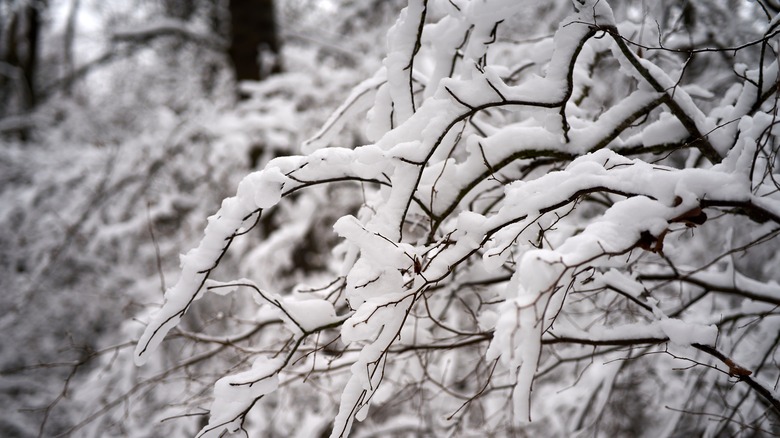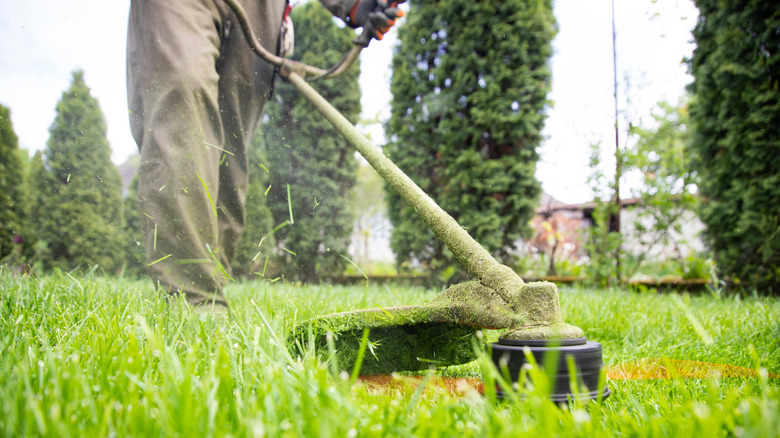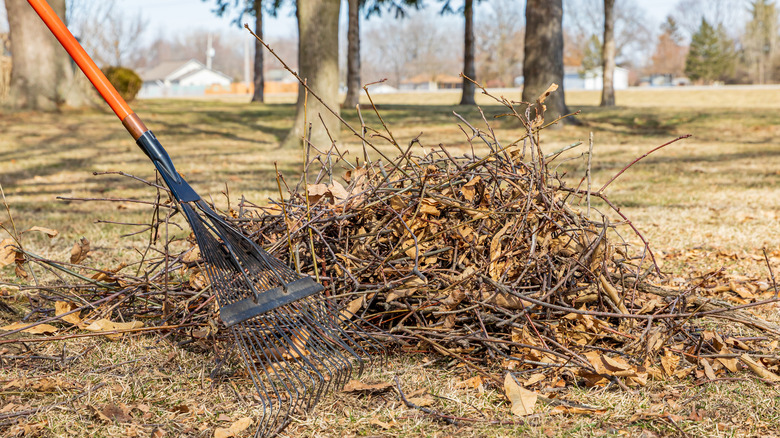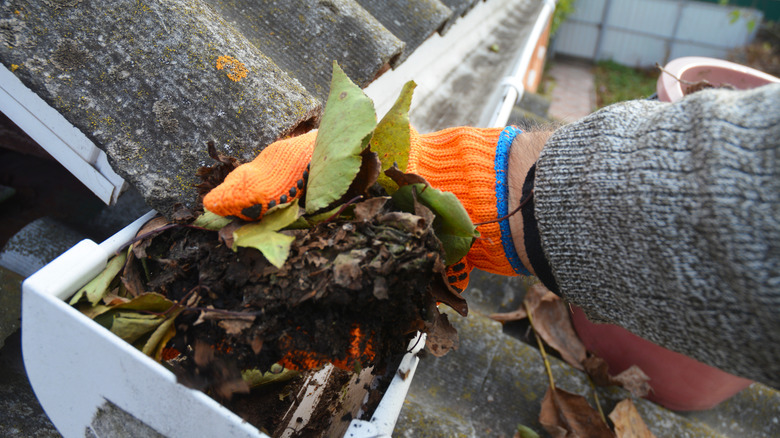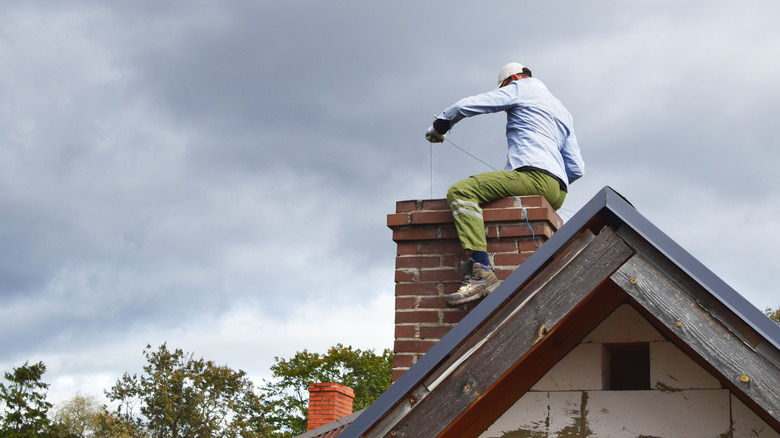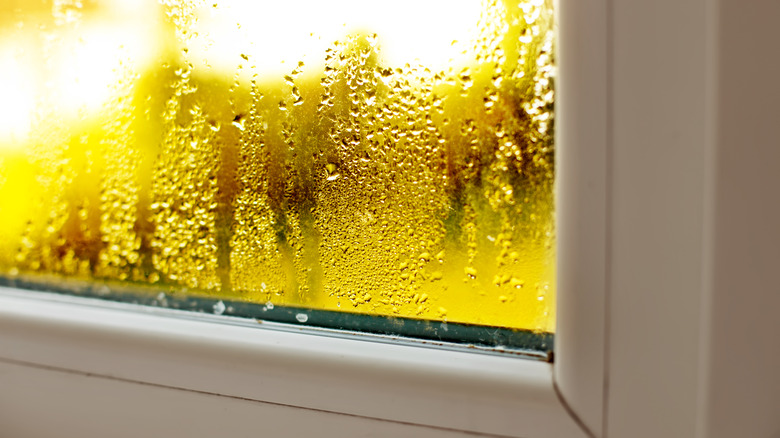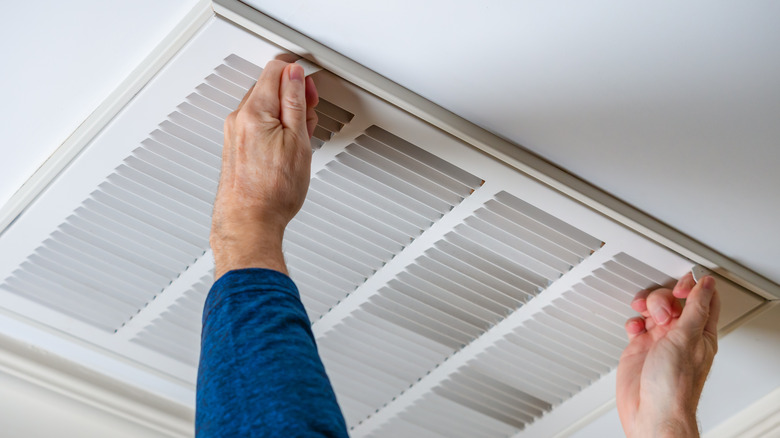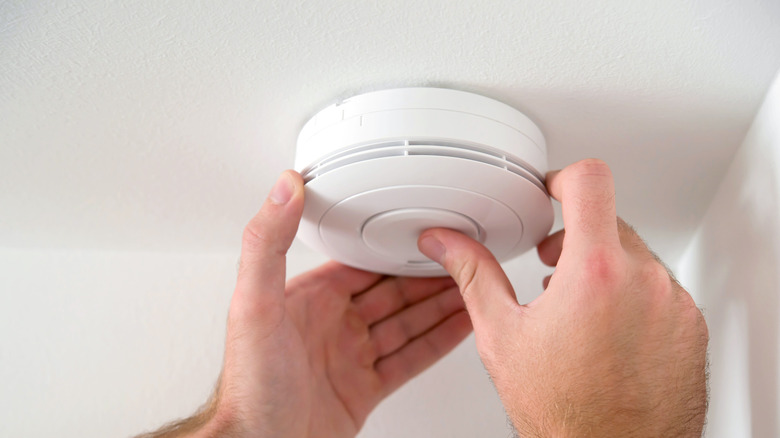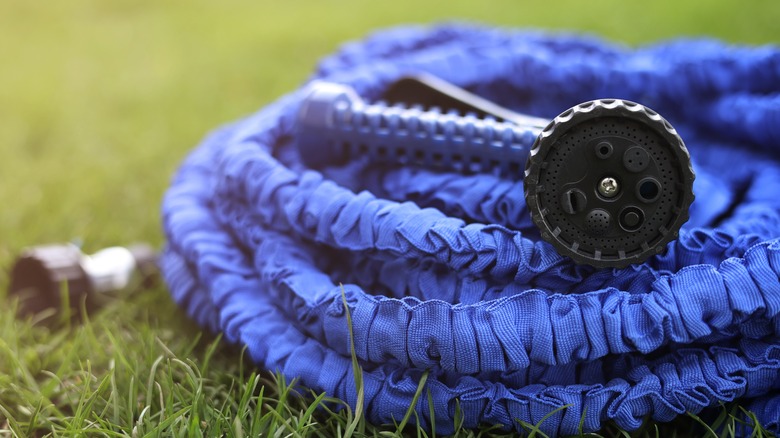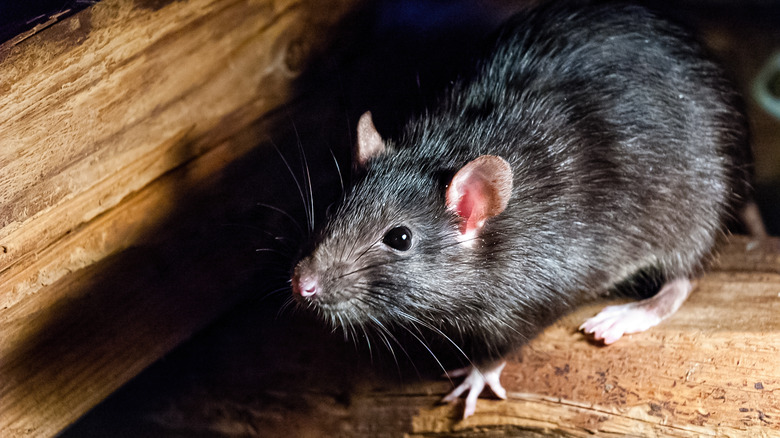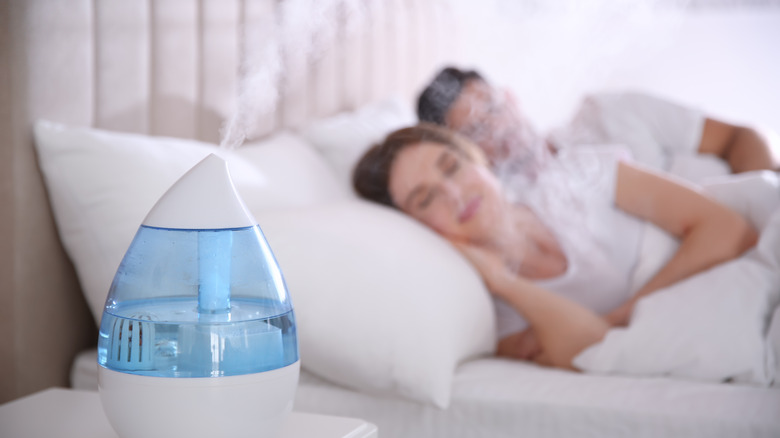How To Prep Your Home For Cold Weather
Everyone's heard of spring cleaning, but the subject of cleaning and preparing during fall might be even more helpful in being both proactive and productive. Noted by the American Cleaning Institute, or ACI, summer is a great time for vacationing and getting away — it's also a great time for dirt, grime, and germs to accumulate as outdoor activities increase and you and your family are constantly running in and out. And with the winter months ahead and holidays fast approaching, fall is an ideal time to get some thorough house cleaning done.
While there is plenty to clean and repair inside the home, such as loads of laundry and tending to your appliances (via ACI), there might be even more to tend to outside the home in a more tactical fashion. "'There are certain things you need to do to your home to get ready for the changing of the weather," professional cleaner Sara San Angelo tells Homes & Gardens. "These things are even more important if you live where it snows." Homeowners should take advantage of these last few months before winter to prepare themselves and their homes for the cold weather months ahead. From indoor safety measures to outdoor preventative care, there's plenty to do to get your house in order.
Engage proactive lawn care practices
One of the largest projects is to start preparing the lawn for winter. According to the University of Minnesota, fall is one of the best times for lawn care, as there is much that can be done to not only prepare for winter but the upcoming spring as well. One of these tasks is to reduce how often you mow, as grass growth rates shorten in colder temperatures (via the University of Minnesota). Keeping the grass short before winter especially will also help prevent creatures like voles and mice from uprooting plants. Another way to help keep your grass healthy in time for spring is to aerate your lawn, according to Lawn Love. This will enable water, air, and nutrients to penetrate into the roots of your grass and help them to grow stronger and penetrate deeper into the soil.
From these late-year lawn care practices, you can also begin other proactive gardening tricks. Composting is an excellent practice that you can start any time of year, but fall especially is a great time to start. According to the University of New Hampshire, fallen foliage from the seasonal change is a great starter for a compost pile, as leaves and pine needles are carbon-rich materials. Not only that, compost is one of the best natural fertilizers, according to The Big Green K, and encourages the best kinds of plant growth — great for lawns as well as gardens, flower beds, and so much more.
Treat your trees to some TLC
Keeping to outside tasks, another great way to prepare your home for the upcoming cold weather months is to take some time catering to your trees. Several parts of the trees in your yard can become vulnerable during the wintertime, therefore it is imperative to cater to each aspect from top to bottom.
At the top or tips of the trees, the best way to prepare is to prune and trim back any long, potentially breakable branches. Jim Skiera, a past Executive Director of the International Society of Arboriculture (ISA), tells Horticulture Magazine that proper pruning is "vital to the health of trees and plants, in part because it helps relieve stress on trees and keeps them growing." To prevent even further injury to branches from fallen or heavy snowfall, you can wrap both branches and young tree trunks with a hard, plastic guard or a metal hardware cloth (via Horticulture Magazine).
At the base of your trees, a good practice is to spread mulch and/or fertilizer to ensure the tree has plenty of nutrients for future growth. Unlike trees in a forest, trees in urban and suburban environments face high-stress conditions from surrounding infrastructure and even physical damage, according to RTEC Treecare. Therefore the roots of these trees will benefit from some special attention before winter and spring. And if you're up for it, fall happens to be a great time to plant new trees, as cooler temperatures offer less opportunity for a new tree to succumb to sun scorch or drought.
Clean and care for your gutters
Noted by Pro Tools Reviews, although cleaning rain gutters is no easy or fun task, leaving these tasks undone can result in serious problems. From pooling water that can damage the home's foundation, sidewalk, or driveway, to costly roof leaks that can set you back monetarily, gutters need to be checked and cleaned several times a year to ensure your home's protected from water damage. Especially before the cold winter months when snow and ice pose an even bigger threat, fall is a great time to clear out the muck of the spring and summer, as well as prepare for winter.
There are several methods to clean gutters, the safest being from the ground with an extended cleaning wand/hose to clear away leaves and debris, but you can also choose to use a ladder for height (via Pro Tools Reviews). Using a pressure washer is a great way to release years of built-up debris. It's also recommended to clean out the downspout, which can accumulate gunk as you clean and cause further issues. Regarding downspouts, a great way to prepare these gutters for winter is to invest in a downspout extension to get as much water as far away from your basement foundation as possible, according to The Architect's Diary.
Gutters should also get a thorough inspection in the fall to check for wear and tear, another proactive measure that will help avoid larger problems in the future. The Architect's Diary even recommends having a professional do a gutter installation as a cost-effective way to prevent water damage. These professionals can also install protective measures, including gutter guards, to help even further.
Sweep up and get your chimney checked out
Who doesn't love a roaring fire on a cold fall evening? This type of cozy night can be even more stress-free once you've done a thorough cleaning and inspection of the fireplaces in your home. As a good practice, according to Home Depot, chimneys should be cleaned once a year at least, and because of the advanced nature of the task, it should be done by a professional.
To prep inside the home for chimney cleaning, clean out any unburnt wood or ashes, and take away any fireplace tools and screens. Setting out tarps and drop cloths, and even covering the front of the fireplace in plastic, will help from tracking soot and dust all around the home. The cleaning process then involves climbing to the roof, removing the rain cap from the top of the chimney, and using a variety of tools to scrub and remove soot, dirt, and dust from the chimney flue. These are possible to do on your own, but it is recommended to have a professional service done.
Professional chimney sweeps, such as Clay Thompson, have great insight into burning fires safely and as eco-friendly as possible. For instance, arranging the wood on your pile as close together in the center helps produce the "hottest and hence cleanest-burning fire possible," he notes to Mother Jones. Another trick to help safely burn is to "seasoned wood" that's been dry for at least a year, also noting that hardwoods like maple, ash, oak, and beech burn hotter than softwoods, such as pine and fir (via Mother Jones).
Inspect home for areas of area leakage
Finding a cold draft in your home is undoubtedly an annoyance, but if left untreated can cause both short and long-term problems. These air leaks, according to the U.S. Department of Energy, not only let your conditioned air out and outside air in, but can contribute to moisture imbalances in the home, leading to potential problems with your family's health and the structural integrity of the home itself. The fall brings colder weather, making it easier to spot these air leaks and time to take care of these issues before winter sets in.
The Department of Energy recommends caulking and weatherstripping as two simple, effective air-sealing techniques. Areas in the home that are especially susceptible to leaks and should be checked are spots with plumbing, ducting, or electrical wiring that comes up through walls, floors, and ceilings. There are even ways to detect these air leaks, such as holding a candle flame up to window/door frames and light fixtures (via USDE).
Other areas that you might not think of include window frames, chimney flues, and exhaust fans in things like your stove's range hood, according to Wisebread. Once these areas are properly sealed up there are even more ways you can help keep energy costs down that involve air leakage. Installing door sweeps, for example, takes care of extra air leaking out from underneath door frames to the outdoors, garages, and large hallways — these can be easily attained at your local hardware or home improvement store (via Wisebread).
Get your HVAC system serviced
HVAC is every homeowner's favorite system when it's working, and least favorite when it's not. Heating and air conditioning equipment should be inspected, cleaned, and serviced at least once a year, according to Hannabery, with the heating system ideally serviced in the fall.
Cleaning and checking the vitality of the parts included in the system not only prevents future, more costly issues from arising but also makes the system as a whole more efficient in times when you need it most.
Though entire systems can get checked and cleaned by a professional service, there are tasks you can take on yourself to clean the system. One task can be simply wiping down the air ducts and vents to remove extra dust, even turning on the fans to jostle any loose dust. Cinch Home Systems suggests, along with the cooling system checks, changing the filters for both the furnace and air conditioning. A good way to know that the filters are in need of replacing is by holding the old filter up to a light— if no light can be seen coming through, it is time to replace (via Cinch Home Systems). A good trick is to even set alarms for the next time you should check the filters, perhaps once a season.
Test/check smoke detectors
Every year in the United States, about 2,000 people lose their lives in residential fires, according to the U.S. Consumer Product Safety Commission (CPSC). If that's not reason enough to even give your smoke detector a glance, it's also noted that about two-thirds of home fire deaths occur in homes with no smoke alarms or no working smoke alarms. With winter weather comes increased use of heating systems and fireplaces; because of this fall is the perfect time to check in with the smoke detectors in your home, and to set further precautions in place to ensure safe cold weather months.
The CPSC notes that smoke alarms should be installed on every level of the home, outside sleeping areas, and inside bedrooms, preferably along a potential escape path. With proper installation, check these alarms at least once a month as advised by the U.S. Fire Administration, and replace the batteries once or twice a year, according to Allstate. There are two different types of smoke detectors, battery and hard-wired, and both can become faulty if not checked in a timely fashion. And if your smoke detectors are approaching the end of their life, which is about 10 years, replacement is crucial. The same can also go for fire extinguishers which have the same lifespan, according to Fire Alert.
There are other measures you can take in the fall, along with your smoke detector checks, that pertain to fire safety. As noted previously fall is a great time to check your HVAC system before cold weather sets in; along with the HVAC, the CPSC recommends checking any external heating appliances, such as space heaters, for any faulty wiring, wear, or warranties. These, along with smoke detector and heating system checks, will help prevent unnecessary fire incidents.
Don't forget your outdoor hose and faucets
Though winter isn't here just quite yet, as temperatures dip into the 40s and 50s, it might be a good time to take a look at the plumbing and faucets around your home. When liquid water freezes, it expands as it becomes ice, according to John C. Flood, which can cause a pressure build-up. If not properly catered to, this pressure in the pipes and faucets can burst and cause further damage. Taking the time to "winterize" your plumbing during the fall when temperatures are still above freezing will save you headaches down the road.
The easiest place to start outside is the garden hose. Once you've finished the final harvesting and gardening, it's best to put the hose away for the season. Swan Product notes that if left outside hoses will definitely become damaged come spring, even more so if left attached to a spigot, as the water inside will freeze, rip holes in the internal lining, and cause problems for the plumbing both inside and out. It's recommended to disconnect any hoses from outdoor faucets, let the water drain out entirely, and coil them up for storage. You can also run water through the hoses before draining to clear away any debris or dirt from the handle and hose itself (via Swan Product).
Inside, it is best to check the plumbing for any cracks or leaks, as these will be the first to cause problems. Afterward, a good safeguard is to insulate pipes with insulation sleeves that can be wrapped or slipped on, in order to protect from cold exposure. Insulating your crawl spaces, as well as keeping your heat on, can also help insulate the pipes from inside the home to help prevent leaks or bursts (via John C. Flood).
Prevent critters from finding their way inside
No matter the type of home you live in, old or new, big or small — critters of all shapes and sizes will find their way inside. According to Tony's Pest Control, to a wild animal, a house is a warm, dry secluded sanctuary, an ideal shelter from harsh weather. Small dark spaces, such as an attic, basement, garage, even in the walls, are especially appealing, away from attention and potentially great places to find or store food. Cold temperatures drive animals to look for a place to hide inside homes, as wildlife control expert Luke Ferguson tells Havahart, which can cause further damage to your walls, wiring, and much more. There are ways to find if you've got an infestation, as well as ways to eradicate these creatures.
You can pretty easily detect critters in your house through any of the five senses, none of which are particularly pleasant. Anything from seeing droppings or holes scratched into the walls, hearing things squeak or scurry around at night, or unfortunately smelling something foul can indicate you've got some unwelcome visitors (via Tony's). Depending on where you live, these creatures can be as small and common as mice or squirrels, or as unpredictable or rare as raccoons or armadillos.
The key to extraditing these pests out of your home? Finding out what is attracting them and how they're getting in. For what's attracting them, it's best to lock up garbage cans, close up any open food containers/remove any food outside that can attract them toward the home, according to Tony's. Ferguson also suggests, when removing pests inside the home, to seal off all entry points and utilize live traps to remove any that you can't force out.
Invest in a good quality air humidifier
According to the Mayo Clinic, an ideal humidity should be between 30 – 50% indoors, though in the colder months heating systems are turned on, leading toward dryer air indoors and less humidity. A good way to balance these conditions is to utilize a humidifier, which uses water vapor to increase the humidity in the air. Humidifiers can often be thought of as a nonessential appliance, but come cold and flu season, these machines might actually be worth investing in.
Though maybe not as readily known, humidity can drastically affect the health of a person in more ways than one. Skin health, for one thing, is key, especially in colder weather where dry temperatures can cause cracked skin and lips. "Air that has a less-than-optimal humidity level, below 40-60 percent, can pull moisture from the skin and dehydrate it, making it appear older and duller," as Dendy Engelman, a dermatologic surgeon, tells Byrdie. Even more detrimental are dry air's effects on sinuses.
According to a 2010 study, humidifiers were proven to help sleeping conditions for those affected by a virus, as well as decrease the survival of the virus itself, according to the National Library of Medicine. "Using a high-quality humidifier will improve your environment by keeping the air at an optimal humidity level, which helps ease allergy and cold symptoms and makes it easier to breathe," Engelman says. In order to keep these benefits, however, humidifiers must be kept clean and fresh with distilled water, as unclean water can counteract any positive effects (via Mayo Clinic). Dermatologist Anna Chacon also notes to not keep the humidity level too high, saying that "If the humidifier's humidity is too high, it is a breeding ground for dust mites, bacteria, and mold" (via Byrdie).
